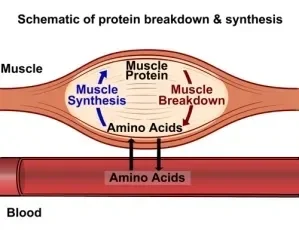Mythbusters: The Protein Craze
Lock in.
Fueled with a newfound motivation to improve your health, you finally decide to open up your phone and dive headfirst into the glittery rabbit hole of fitness media. Next thing you know, your screen is flooded with countless 30-day transformation videos, miracle diet articles, and meal planners. Across all this hype, however, one word echoes louder than the rest: protein.
Soon enough, you notice a recurring obsession for protein within the fitness industry, with it claiming that “protein is nonnegotiable for building muscle.” The message is so simple and confident that you begin to think of it as the missing piece of the puzzle. You even start analyzing your meals, consuming all the juicy meat you can just to hit your daily protein goal.
Even when you walk into a supermarket, you’ll find the word “PROTEIN” plastered and highlighted on products that fill up several shelves. Candy bars disguise themselves as “fitness-friendly,” and even your favorite cookie brand now boasts “20 grams of protein!” on its packaging.
All of this seems too good to be true. It only makes you wonder: Is there truth behind this protein craze? Or is everything just a myth?
Before we answer these questions, let’s ignore all the noise for a moment and go back to the basics of the biological process at the very center of it all.
The process of muscle growth doesn’t just begin with protein; rather, it starts with thousands of microtears in your muscle fibers that are created when you put them under stress and resistance. This process is also referred to as muscle breakdown.
Following this, muscle synthesis begins as your body works to rebuild the torn muscle fibers. This response is triggered when your body senses damage and activates a repair mechanism. A key part of this response is a special pathway in your cells called mechanistic target of rapamycin (mTOR). For mTOR to function, however, it needs to receive direct signals provided by amino acids from the protein you eat.
This is why your protein intake is so critical. When you consume protein, its amino acids are delivered to your muscles, where they activate mTOR. Afterward, your body is directed to begin weaving new protein strands, using the same amino acids as their building blocks. This process rebuilds damaged muscle tissue to be thicker, denser, and therefore stronger than before. Over time, the repeated occurrence of muscle synthesis exceeding muscle breakdown leads to the visible increase in muscle size that defines a better physique.
This process is simple, yet often misunderstood by many. Online, these facts are often pushed to an illogical extreme, which has created the most pervasive myths in all of fitness.
Myth 1: More protein, more muscle.
After understanding protein synthesis, it may seem counterintuitive to think that more protein does not actually result in greater muscle mass. But in truth, your body has a functional limit to how much protein it can actually use at once. Once this limit is exceeded, any extra protein will be either used for energy or stored as fat (which we don’t want).
For most active people, 1.2 to 1.7 grams of protein per kilogram of body weight is more than enough to maximize muscle growth. Based on this range, a typical gymgoer weighing 80 kilograms would ideally have their daily protein goals be at least 96 and at most 136 grams. Accounting for food being evenly distributed throughout the day, the math tells us that consuming meals with more than 45 grams of protein would provide little to no additional benefits, as the body’s synthesis process would already be running at peak capacity. It also wouldn’t be the most financially wise choice for a diet plan!
Myth 2: Animal protein is better than plant protein.
As previously mentioned, amino acids are the building blocks of protein. Of these, your body has nine essential amino acids (EAAs) that it cannot produce on its own and must obtain from your diet. Because animal proteins usually contain all nine EAAs, unlike most plant proteins, which may lack one or two, they are often considered more “complete” and therefore superior.
This does not entirely discredit the effectiveness of plant proteins, though, as having a balanced and varied diet can more than offset this difference. For example, rice is low in the EAA lysine but abundant in methionine. Conversely, beans lack methionine but are plentiful in lysine. Together, they create a balanced amino acid profile that can be just as effective as a slice of meat for supporting muscle synthesis.
Myth 3: Protein supplements can substitute for whole-protein foods.
Protein supplements are made by extracting protein, usually from milk, eggs, or soy, and processing it into powdered form. While they are convenient and can deliver a quick dose of protein, that is all they can deliver. Replacing whole-protein foods with supplements would strip your diet of other important nutrients such as fiber, antioxidants, vitamins, and more.
Moreover, many protein supplements contain added sugars and artificial flavors, offering little nutritional value. In contrast, whole-protein foods can support overall health beyond muscles, from digestion to immune function.
In short, staying healthy requires a balanced diet, mindful intake, and clear understanding of how your body utilizes protein. To make effective steps towards your health and fitness goals, it is important to look past the marketing, debunk online myths, and focus on what actually works for your body.
Remember: eat smart, not hard!
Sources:
https://www.health.harvard.edu/staying-healthy/extra-protein-does-not-build-more-muscle
https://katclassics.wordpress.com/tag/muscles/
https://www.healthline.com/nutrition/animal-vs-plant-protein
https://www.healthline.com/nutrition/do-protein-shakes-work#dietary-supplement
https://www.menshealth.com/uk/nutrition/a755033/the-8-most-common-protein-shake-mistakes/

